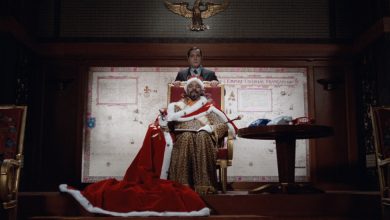5 Minutes That Will Make You Love the Horn

In the past we’ve chosen the five minutes or so we would play to make our friends fall in love with classical music, piano, opera, cello, Mozart, 21st-century composers, violin, Baroque music, sopranos, Beethoven, flute, string quartets, tenors, Brahms, choral music, percussion, symphonies, Stravinsky, trumpet, Maria Callas, Bach, the organ, mezzo-sopranos, music for dance, Wagner and Renaissance music.
Now we want to convince those curious friends to love the golden, mellow sunshine of the horn. We hope you find lots here to discover and enjoy; leave your favorites in the comments.
◆ ◆ ◆
Sarah Willis, Berlin Philharmonic hornist
The French horn is so versatile. Heroic, romantic, scary, mysterious — you name it, the horn can play that part. And it’s a sociable instrument: We love to play together. In the third movement of Richard Strauss’s Horn Concerto No. 2, the horn is a virtuosic and passionate hero, which the horns in the orchestra join at the end of the movement for a final fanfare. These last moments always lift my heart and make me proud to be a horn player.
Strauss’s Horn Concerto No. 2
Norbert Hauptmann, horn; Berlin Philharmonic; Herbert von Karajan, conductor (Deutsche Grammophon)
◆ ◆ ◆
Akshaya Avril Tucker, composer
Give me a long, quiet note on the horn and I feel like I’ve entered a place of timelessness. It’s an incredibly soothing, supportive sound — the best sonic cuddle buddy. In orchestration classes, I’ve heard the horn referred to as “glue”; it cushions and supports its neighbors in the orchestra like no other instrument. Jonathan Dove’s “Susanna in the Rain,” from his “Figures in the Garden,” is utter comfort. A small ensemble of woodwinds provides a gentle pitter-patter of rain, while the horn — first one, then two — soars above. When I listen on the drought-stricken West Coast to these yearning melodies, they sound like a nourishing downpour.
Dove’s “Susanna in the Rain”
Orchestra of the Age of Enlightenment; Antony Pay, conductor (Warner)
◆ ◆ ◆
Paquito D’Rivera, saxophonist and composer
The French horn — a rather exotic instrument in the history of jazz — has among its most creative practitioners Willy Ruff, John Grass, David Amram, Gunther Schuller, John Clark and Chris Komer; I just composed a piece for Komer and the New Jersey Symphony Orchestra. But we always have to mention Julius Watkins, considered by many the father of the modern jazz French horn, and a good example of his masterful work — transcribed by the Brazilian hornist-composer Victor Prado — is this interesting improvised solo on “Phantom’s Blues,” recorded with the Quincy Jones Orchestra in 1960.
“Phantom’s Blues”
Julius Watkins, horn; Quincy Jones Orchestra
◆ ◆ ◆
Franz Welser-Möst, Cleveland Orchestra conductor
The horn has this beautiful, warm, singing sound, which resembles the middle register of the human voice; that is why it is so easy to connect to. The horn is sort of the cello of the brass section. The violins, trumpet and flute are in a high register, and not many people can sing that high, while the register in which the horn plays is accessible to anybody.
I chose the opening of the third movement of Mahler’s Fifth Symphony, simply because people usually think of the horn as a hunting instrument. The horn here represents the crying out of the human soul, sort of lost in the ocean of an overwhelming world. In this section, the horn is an individual human voice surrounded by a crazy, dancing universe of other instruments. Mahler was a contemporary of Sigmund Freud, so his music is always about the psyche — of an individual and of humanity.
Mahler’s Fifth Symphony
Vienna Philharmonic; Leonard Bernstein, conductor (Deutsche Grammophon)
◆ ◆ ◆
Zachary Woolfe, Times classical music critic
Brahms’s mother died early in 1865; later that year, he wrote a trio for violin, piano and horn, an instrument he had learned as a child. The result — for which he specified the affably rustic, if difficult to control, valveless horn, rather than the newer valved variety — is by turns serene, agitated, mournful and joyful, with the horn throughout evoking walks in nature and an ineffable nostalgia.
Brahms’s Horn Trio
Myron Bloom, horn; Rudolf Serkin, piano; Michael Tree, violin (Sony)
◆ ◆ ◆
Seth Colter Walls, Times writer
The horn, with its mellow colors, doesn’t always conjure pure relaxation; it can be regal even in passages of tranquillity. The composer William Bolcom uses this simultaneously lyrical and potent quality during stretches of his Trio for Horn, Violin and Piano, created in response to Brahms’s famous trio. But in the final movement — which he has described as a “resolute march of resistance,” written in the wake of the 2016 election — Bolcom lets the instrument strut, with some raucous pressurized notes, drawing it closer to its more jazz-associated cousins in the brass section.
Bolcom’s Horn Trio
Steven Gross, horn; Philip Ficsor; violin; Constantine Finehouse, piano (Naxos)
◆ ◆ ◆
Kevin Newton, Imani Winds hornist
“Ecos oníricos de la Basílica de San Marcos” was written for me by the Argentine composer José Manuel Serrano. The piece, for a soloist and prerecorded horns, transforms the sound of the horn into ghostly echoes in a cathedral, requiring the player to access a wide range of textures and microtones.
For me, the horn has always been an extension of the voice. My childhood was filled with many a long car ride in which my mother would teach me to sing harmony, as well as choir rehearsals and weekend mornings at the piano working out hymns or whatever else of her songbooks I could get my hands on. When I first heard the horn, I wished that my voice could produce those sounds, and a love for the instrument was born. Its flexibility has freed me from the limitations of my own voice, and this piece is a wonderful space to explore that freedom.
Serrano’s “Ecos oníricos de la Basílica de San Marcos”
Kevin Newton
◆ ◆ ◆
Mei-Ann Chen, Chicago Sinfonietta conductor
I knew Erich Wolfgang Korngold’s granddaughter, Katy Korngold Hubbard, before I knew his music. Once, driving in the rain, I had to pull over to the side of the road because I was so incredibly moved by the sublime music on the radio. I didn’t know the composer. The last movement of the mystery work — it turned out to be Korngold’s “Much Ado About Nothing” Suite — was so joyful and witty, featuring the horns prominently, that I was transported to a different world. I became a huge Korngold fan. This rarely performed work should be better known.
Korngold’s “Much Ado About Nothing” Suite
Orchestre Philharmonique de Strasbourg; Marc Albrecht, conductor (Pentatone)
◆ ◆ ◆
Bernard Labadie, Orchestra of St. Luke’s conductor
Deep in the German psyche, the horn is closely associated with the forest — not only in relation to hunting but also to the romantic idea of night, moonlight and starry skies. No piece of music epitomizes this connection like Schubert’s “Nachtgesang im Walde” (“Nighttime Song in the Forest”), written for a four-part men’s choir and four horns. This highly unusual formation explains why this little masterpiece is a rare guest on concert stages. And yet what fabulous music this is, with Schubert’s unmistakable mixture of harmonic magic and deep connection with text. Never has the sound of the horn felt so simultaneously grounded and ethereal.
Schubert’s “Nachtgesang im Walde”
Monteverdi Choir; John Eliot Gardiner, conductor (Philips)
◆ ◆ ◆
Mark Almond, San Francisco Symphony hornist
Conductors and fellow musicians never seem to mind how loudly you can blow the horn, but they really, really care about how softly you can play; in fact, your career depends on it. As the natural harmonics of the instrument are very close together in the high register, playing pianissimo in that range requires laser focus and surgical precision. Next time you’re at the symphony, imagine the hornists as darts players, having to throw bull’s-eyes every 20 seconds for 45 minutes. Then imagine the conductor standing next to the dart board, silently urging the player to throw each dart as gently as possible, but still demanding that the bull’s-eye be hit every time.
The flip side: It’s incredibly liberating to play pieces in which you can just let it rip and go for it, as loudly as (tastefully) possible, like in this exciting recording of Haydn’s “Hornsignal”Symphony, performed by the natural horn players — no valves! — of the Concentus Musicus Wien.
Haydn’s “Hornsignal” Symphony
Concentus Musicus Wien; Nikolaus Harnoncourt, conductor (Warner)
◆ ◆ ◆
David Allen, Times writer
Deep into Strauss’s last opera, “Capriccio,” comes one of the most magical moments that ever flowed from his pen. A countess has to choose between the love of a poet and a composer — between the primacy of words and music. She never quite makes a selection, but before the final scene, in which she wrestles with her fate, Strauss makes his own feelings clear. As evening falls and the moon lights the scene, a horn glows in the dusk.
It’s a profoundly moving interlude, and this is a profoundly moving account, a tribute from one horn player of distinction, Alan Civil, to a colleague who was arguably the greatest of them all: Dennis Brain, the principal horn of the Philharmonia Orchestra, who was killed in a car crash in 1957, two days before the sessions for this first recording of the work.
Strauss’s “Capriccio”
Philharmonia Orchestra; Wolfgang Sawallisch, conductor (Warner)
◆ ◆ ◆





